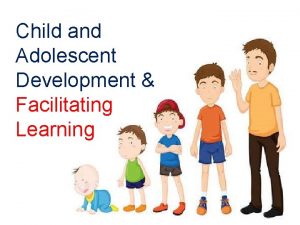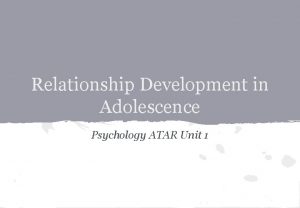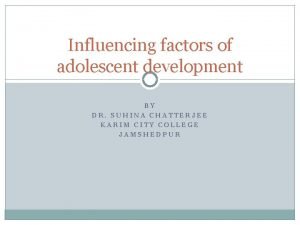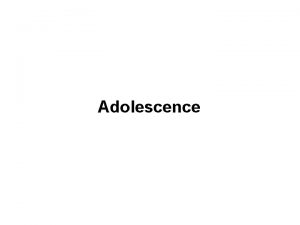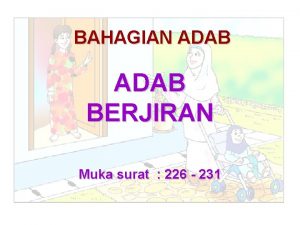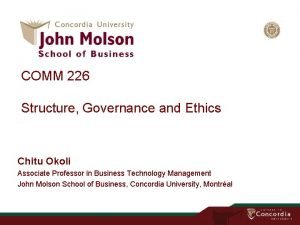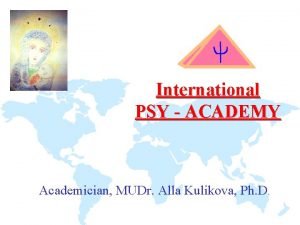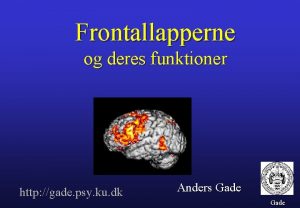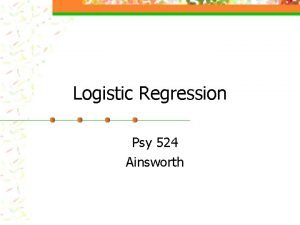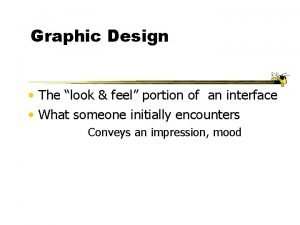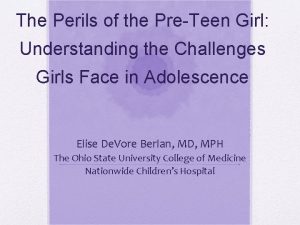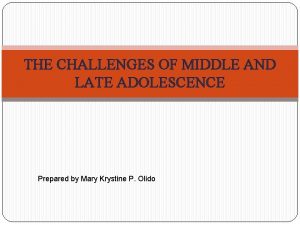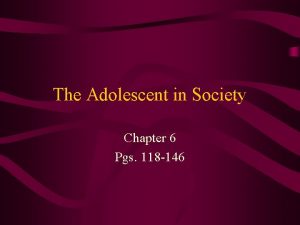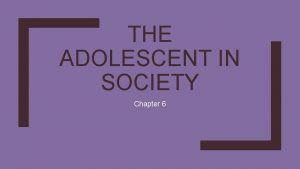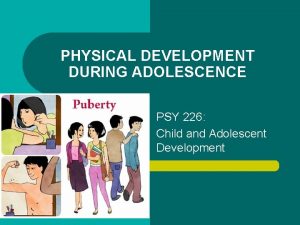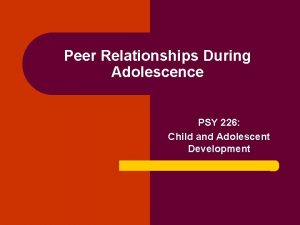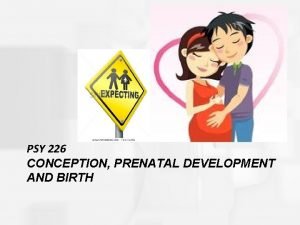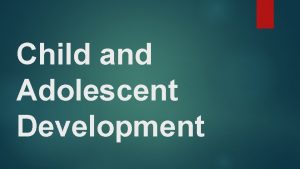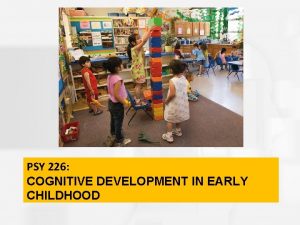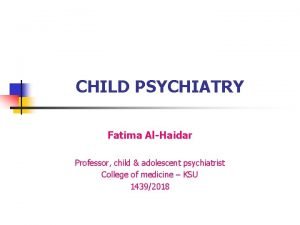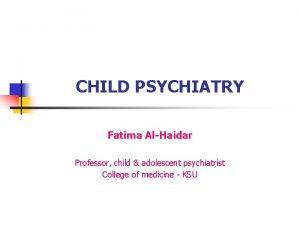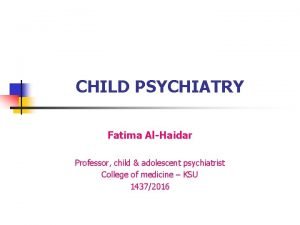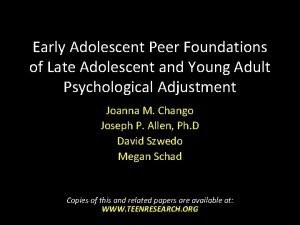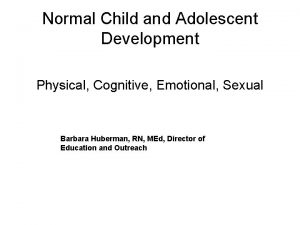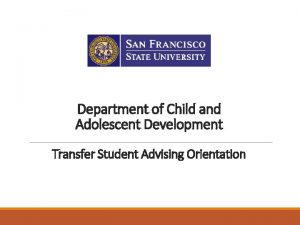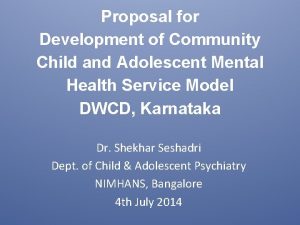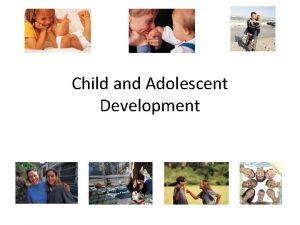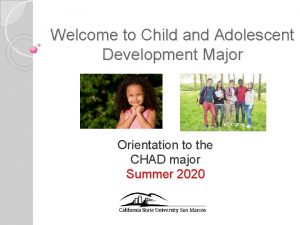PSY 226 CHILD AND ADOLESCENT DEVELOPMENT NATURE WITH

























![It is an impossibility… “The only adoption study that would avoid such [problems] would It is an impossibility… “The only adoption study that would avoid such [problems] would](https://slidetodoc.com/presentation_image/84f9612b81a8aad5c8d33b6e699ffdfb/image-26.jpg)













- Slides: 39

PSY 226: CHILD AND ADOLESCENT DEVELOPMENT NATURE WITH NURTURE

Why are these kids… …Depressed? …Happy? …Intelligent?

Learning Objectives (1) Understand the following perspectives: • Development is driven by nature. • Development is driven by nurture. • Development is part nature, part nurture. (2) Be able to discuss how and why the concept of heritability is flawed. (3) Be able to discuss with examples the idea that nature and nurture are parts of the same whole and development is driven by the process of epigenesis. (4) Give examples of gene-environment correlations (active, passive, evocative)

Genetic Myths • Complex behavior(s) or characteristic(s) such as intelligence, aggression, emotion, and obesity are not caused by a single gene. • There are no naked genes. Genes are “wrapped” in multiple contexts. – Cell nucleus, cell, organ system, body and brain, multiple interacting extra -organism contexts

Development is Driven by Nature • Preformation – born to sin? • Rousseau’s “innocent” babies – Children are innocent at birth and develop according to nature’s plan • Genetic determinism and eugenics (good genes) – Individual cannot be changed by nurture or education – Advocate controlled breeding to encourage childbearing among people with “desirable” characteristics

Development is Driven by Nurture • The Blank Slate – Locke’s view of the mind “tabula rasa” – Everything is the result of experience • Watson’s Behaviorism – Strict “fundamentalist” version of environmentalism "Give me a dozen healthy infants, well-formed, and my own specified world to bring them up in and I'll guarantee to take any one at random and train him to become any type of specialist I might select--doctor, lawyer, artist, merchant-chief, and, yes, even beggarman and thief, regardless of his talents, penchants, tendencies, abilities, vocations, and race of his ancestors. I am going beyond my facts and I admit it, but so have the advocates of the contrary and they have been doing it for many thousands of years. " –John B. Watson, Behaviorism, 1930

Why are these extreme ideas so popular?

VIDEO: Methods in Behavioral Genetics http: //study. com/academy/lesson/twin-and-adoption-studies-practices-findings. html 7: 00

Fraternal and Identical Twins Fraternal “twins” from separate eggs are not any more geneticall y alike than other siblings. To assess the impact of nature and nurture, how do we examine how genes make a difference within the same environment?

Development is Part Nature, Part Nurture • Heritability – The extent to which a phenotypic trait* is due to genes 1. Twin studies • H 2 = 2 (r. MZ – r. DZ) 2. Adoption studies 3. Family relatedness studies *A phenotype is an observable characteristic resulting from ones genotype and environment

Heritability of Traits in Twins Heritability Indices (Bouchard et al. 1990) Height =. 90 Intelligence (IQ) =. 50 Personality (Big 5) =. 50 Vocational/Recreational Interests =. 50

Shared and Non-Shared Environment • Shared Environment – the environment that children growing up in the same home have in common – Parenting style, food choices, school system, neighborhood characteristics • Non-Shared Environment – the environment that children growing up together do not share – Sibling treatment, birth order effects, different peers, classrooms, teachers – Behavior geneticist argue that most of our home environments are non-shared and that parents do not matter very much anyway

Wait, What? Parents Don’t Matter? Role Models Albert Bandura’s social learning theory explains that children learn by watching and imitating others (role models). If so, then we should be able change behavior by changing children’s experience of role models. Imagine you’re a child development specialist. Using Bandura’s social learning theory, what would you advise the following parents to do?

Child Cases 1. Anura has a 2 -year-old daughter and wants her to love to read books. 2. Orpheus wants to encourage his 3 -year-old son to excel in art or music. 3. Sharna and Bronislaw are about to have a child and want to him/her to be ecologically responsible (recycle, use energy wisely, not to be frivolous with money or waste food).

A 2014 Critique of Heritability

Behavioral Genetics Critique I Hope My Partner Read the Chapter Think-Pair-Share Identify 2 Criticisms of the Concept of Heritability

Methodological Problems: Twin Studies • Equal Environment Assumption (EEA): The environment of MZ co-twins is no more similar than that of DZ co-twins. • In what ways might this be wrong?

MZs are more likely than DZs: • • to be treated more similarly by their parents to brought up “as a unit” to have the same friends to be “inseparable” as children – to spend time together – to go out together • to report greater closeness and mutual influence • to share bedrooms and clothes • to share experiences like identity confusion Ignoring this inflates the heritability coefficient

Methodological Problems: Twin Studies • The Genderless Assumption (GE): It does not matter if the DZ twins are same sex or opposite sex. • In what ways might this be wrong?

Kinship Studies: Average Proportion of Genes Shared

Methodological Problems • Believe it or not… the genderless and equal environments assumption are usually followed in kinship studies too (twins, siblings, cousins). • Therefore, the environments of pairs of opposite-sex cousins are deemed no less similar than identical twins. – Note: Cousins and siblings don’t share age either!

Methodological Problems: Adoption Studies • If we study siblings that have been adopted apart, then that satisfies the equal environment assumption. • In what ways might this be wrong?

The Environments of Adoptees are Selected (not random) • Late separation – Prenatal and early childhood influences can have lasting effects • Non-representative environments – Seldom adopted to high risk settings – Adopted parents are more affluent, educated, live in better communities than the general population • Selective placements – – They want to be parents Parents are carefully screened Parents want to participate in research Least desirable kids and parents are matched

What if Environment is Really Different?

What if the Twins’ Environment is Really Different?
![It is an impossibility The only adoption study that would avoid such problems would It is an impossibility… “The only adoption study that would avoid such [problems] would](https://slidetodoc.com/presentation_image/84f9612b81a8aad5c8d33b6e699ffdfb/image-26.jpg)
It is an impossibility… “The only adoption study that would avoid such [problems] would be one in which adoptees were randomly assigned to parents, with both groups blind to the treatment (i. e. , not knowing whether they were adopted or not) – all while prenatal environment was held constant. In other words, it is an impossibility to reliably estimate genetic heritability using [the adoption method]. (Conley, 2011; p. 597)

Conceptual Problems • “Heritability studies rest on a model of gene function that views genetic effects as independent and separable from the environmental context in which they operate. Genes don’t work that way. [They] are only one part of an interactive, developmental biopsychosocial system. …thus, it is nonsensical to attempt to partition genetic from environmental influences on phenotypes. ” (p. 225)

The Geno-Centric Model of Behavior Genes activate themselves to code for the production of protein and build the person and his/her personality.

Epigenetic Model Epigenetic means “All around creation” • DNA is not “self acting. ” It is a catalyst and has to be transcribed. It must first be activated. • Whether genes stay dormant or turn on/off, when and for how long, depends on the intracellular environment. • The intra-cellular environment is affected by the extra-cellular environment, and so on… • The genome itself is dynamic and composed of elements that undergo deletion, insertion, and rearrangement.

Model of Behavioral Epigensis • All levels of organization interact continuously over time. • Genes effect and are effected by this process (co-effecting).

Conclusion “Heritability studies do not resolve the outworn nature-versusnurture debate; they promote it. ” “…we call for an end to heritability studies…” (p. 225)

Gene-Environment Correlations • Active: The correlation between the child’s genetic endowment and the choices the child makes about which environments they will seek. • Passive: The correlation between the genetic endowment parents give their children and the environments in which they place their children. • Evocative: The correlation between the genetic endowment of the child and responses the child elicits from other people.

Capisce? Gene-Environment Interactions and Conception Section A Section B

The Remarkable Contributions of Zing-Yang Kuo

Understanding Your Theoretical Potential • The zygote (fertilized egg) starts to develop with an extremely wide, but not unlimited, range of behavioral potentials. Only a very small fraction can be realized. • A more diverse the environment allows for more diversity in behavior patterns. • Usually the range of diversity in the environment is limited so we see restricted range of behaviors. This can provide an illusion of genetic determinism, particularly in early development (e. g. , instincts). • BUT, if we manipulate the environment during development we can create “behavioral neo-phenotypes” that are not ordinarily observed.

Instincts and Experience Even so-called “Instincts” such as a chicken pecking at mealworms are malleable according to prenatal and postnatal experience a) Post-hatch pecking has developmental antecedents prior to hatching (e. g. , heart beat and head movements). b) Post-hatch pecking has developmental antecedents in early experience (e. g. , visual, neuromuscular, balance). “In other words, pecking is such a complex process of prehatching and posthatching development, involving so many morphological, physiological, and environmental factors, that it would be quite naïve to argue whether it is “innate” or “learned” or whether or not this behavior had already been acquired in the shell. ” Source: Kuo (1967; p. 109)

Instincts and Experiences Kittens can be raised to be rat fearing, bird loving, to love some rats and kill only shaved rats, or to kill mice while being friendly to white rats (pp. 6364). Asian song thrushes (“predators”) can grow up to be eaters of small birds or to be friendly and protective of them (p. 66). Dogs – separated from their mother after birth – can be raised to prefer a diet only consisting of soybeans, fruit and vegetables, or assorted foods even when starving (p. 68). “This can be accomplished without punishment or reward. Which is due to nature and which is due to nurture? ” (Kuo, 1967; p. 116) “This means that it is impossible to pin down how much of trait is influenced by genes. The heritability of a trait depends on the environment. ” (Steinberg et al. , 2011; p. 58)

A Human Embryonic Stem Cell “We are literally sitting on parts of body that might have been used for thinking!” - Gilbert Gottlieb

Learning Objectives (1) Understand the following perspectives: • Development is driven by nature. • Development is driven by nurture. • Development is part nature, part nurture. (2) Be able to discuss how and why the concept of heritability is flawed. (3) Be able to discuss with examples the idea that nature and nurture are parts of the same whole and development is driven by the process of epigenesis. (4) Give examples of gene-environment correlations (active, passive, evocative)
 Psy 226
Psy 226 Scaffold and fade-away technique
Scaffold and fade-away technique Infants and children 8th edition
Infants and children 8th edition Dexter dunphy 5 stages
Dexter dunphy 5 stages What factors influence adolescent development
What factors influence adolescent development Physical development
Physical development 226 curepipe
226 curepipe Acuerdo gubernativo 226-2008
Acuerdo gubernativo 226-2008 Pengertian berjiran
Pengertian berjiran Cmpe226
Cmpe226 Comm 226 quiz 1
Comm 226 quiz 1 Comm 226
Comm 226 Euro psy
Euro psy Ucf psychology tracks
Ucf psychology tracks Psy 2055
Psy 2055 Psy 2055
Psy 2055 Xxxxblue
Xxxxblue Psy
Psy Psy sanin
Psy sanin Psy
Psy Psy
Psy Psy
Psy Psy
Psy Suppose twin teenagers are vying
Suppose twin teenagers are vying Alla kulikova
Alla kulikova Psy ku
Psy ku Psy walsh
Psy walsh Opis mačky po anglicky
Opis mačky po anglicky Vzor srdce slova
Vzor srdce slova 11 psy
11 psy Regression psy
Regression psy Psy
Psy What is adoloscence
What is adoloscence Nature and nature's laws lay hid in night meaning
Nature and nature's laws lay hid in night meaning 전위 순회
전위 순회 Pre adolescent girl
Pre adolescent girl The challenges of middle and late adolescence
The challenges of middle and late adolescence Chapter 6 the adolescent in society
Chapter 6 the adolescent in society Chapter 6 the adolescent in society
Chapter 6 the adolescent in society Adolescents defenition
Adolescents defenition

